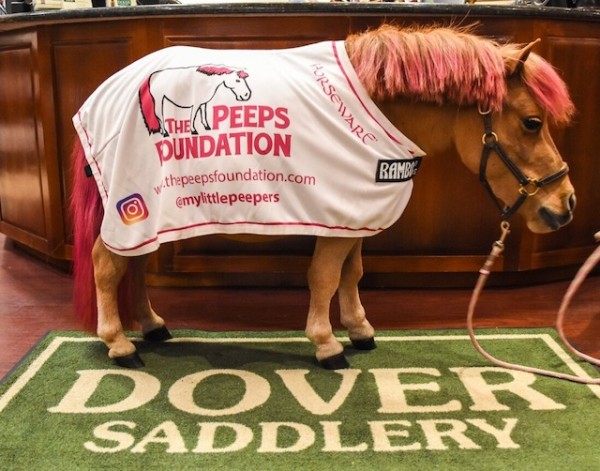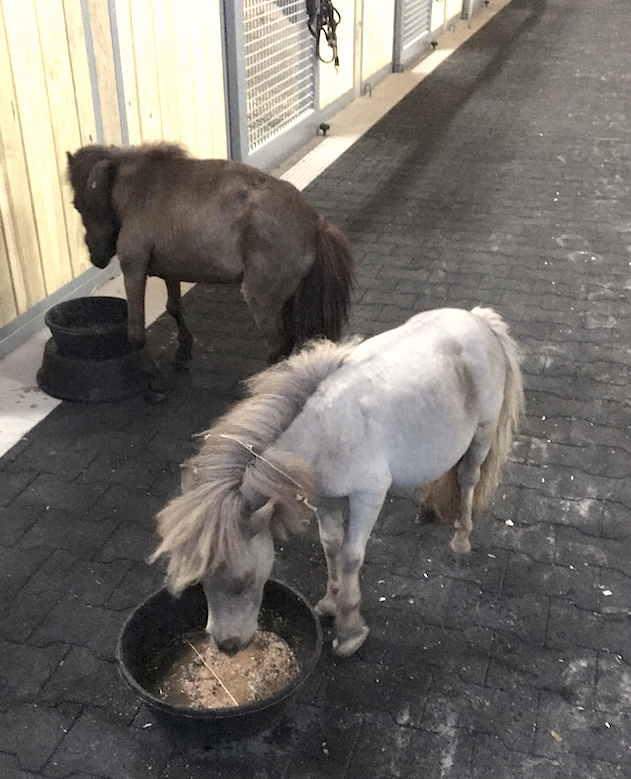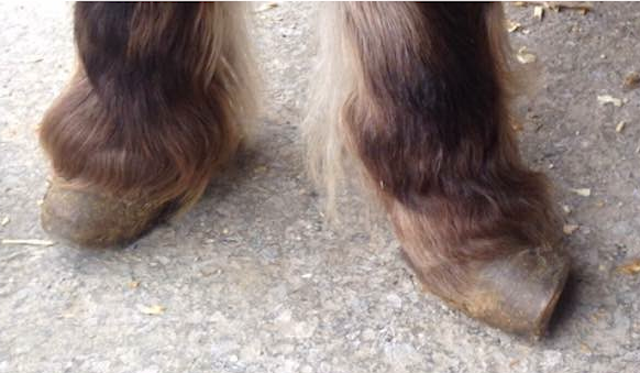Holiday Giving, Equestrian Style: The Peeps Foundation is the horse world’s smallest–and cutest–charity
- March 10, 2017
- ⎯ Fran Jurga

Equine rescue charities are universally noble, hard-working, and struggling to survive. But one is cute, cuddly and an overwhelming success. Meet The Peeps Foundation, founded by hunter/jumper riders on a mission to re-home (and glamorize) miniature horses challenged by the ill health effects of dwarfism. With perfectly banged tails, pulled manes, and crooked legs, the proud Peeps herd wants to win your heart–and probably will.
Tomorrow is #GivingTuesday, the annual day of donations to non-profits in the spirit of the holidays. We’re encouraged to be generous and support our favorite organizations on this day of holiday largesse.
But in this age of social media, we’re bombarded with news and appeals from non-profits all year round. Many people say they feel immune to even the most shocking welfare violations. They’ve heard and seen in all before. Their news feeds are full of it every day. Some even suggest that organizations sensationalize the plight of horses and other animals in order to fundraise–and that they don’t know how or if the funds ever reach or directly benefit the animals themselves.
What’s a well-meaning charity to do?
While the tone and volume of formulaic fundraising is unlikely to change, the landscape around it is evolving. Everyone wants to do something to help horses, and most of us do, whether with our annual checks or with our volunteer services. Even sharing social media messages from the charities you support can be a gesture of charity. They need us.

But for some people the idea of helping horses has meant the rolling up of sleeves and the simple act of performing the now-famous gesture of Loren Eisley’s “Starfish Story”–making a difference to one starfish by putting it back in the sea, even if you can’t possibly rescue every one of them stranded on the beach by the departing tide.
You may have a “starfish” in your own barn, a rescued horse or a repurposed racehorse whose future might have been anything but bright if you hadn’t come along when you did. Maybe you have a barn cat or a puppy or even a guppy that needed a home, and you said that important word: “Yes.” You took them in.

Unlike the dog world, which has countless breed-specific rescues and focused charities for gun dogs or Greyhounds and a raft of others, the horse world has been slow to specialize. Early exceptions have been Our Mims Retirement Farm in Kentucky, which aims to benefit retired broodmares, and the veterinarian-led Connecticut Draft Horse Rescue. The original specialist charities are from the UK, where The Donkey Sanctuary limited its efforts to needy donkeys, and The Brooke, which began to specifically support medical care for World War I military horses abandoned in the Middle East after the war and put to work on the streets of Cairo.
Adoption is now second-nature in the US horse industry. We’re proud of our rescues. There’s a story behind every horse in every stall at some boarding barns. We’re supportive of the non-profits doing the heavy lifting to find, rehabilitate and re-train horses in need. If you have a special interest in the horse world, chances are that there is now or will soon be a charity that is dedicated to rehabilitating or rehoming that breed or type of horse.

In the back pages of the websites of many horse rescues is the story of how the organization really started. George Thorndike Angell, founder of the Massachusetts Society for the Prevention of Cruelty to Animals, was so inspired by Anna Sewell’s Black Beauty that he had his fledgling group publish the first American edition–and sold a million copies of it.
Some of us support with our checkbooks, some as volunteers. Some of us write about what’s going on, some take photos of horse in need, and still others are happy to march in protest rallies, ask people to sign petitions or stick labels on envelopes for donation drives.

We follow in Angell’s hoofprints by bringing home one “starfish” horse at a time, by supporting the work of those who save hundreds at a time, and by looking for that one spark that rings true in our hearts and defines our personal role and potential legacy in the equine welfare paradigm.
If you’re looking for inspiration this holiday season, look no further than Josh Dolan and Alex Granato, who put all these pieces together. You may know their names from horse shows, and never thought that they would have the time or interest to help the shaggy, humpbacked little gnome-like dwarfs who limp around the edges of the horse world.
Let’s put it this way: you either think these horses are cute, or you run the other way. Josh and Alex not only thought they were cute, they ran toward them, gathered them up in their arms, and brought them home.

“Home” is all relative, when you are a professional horse show rider. The original rescue took place at a farm that was just a stone’s throw from the Split Rock Farm Jumping Show in Kentucky. Josh and Alex were there to ride. By the time they moved on to the next show, they had 20 minis to figure out how to transport there.
Now wherever they go, whether to Lexington, Tryon or Wellington’s Winter Equestrian Festival, and many places between, Josh and Alex have an entourage with them in addition to their show string. Miniature horses live in stalls designed for 17-hand warmbloods. They’re groomed by professionals delighted to experiment with hair dyes and unique braiding techniques. Their feet are polished, their pasterns clipped and their manes and tails would earn any show pony’s envy.
But what Josh wishes for is that all the spit and polish applied to the adoptees will make people see them in a new light, and also build awareness of the need for responsible breeding of miniature horses, and the need for more research into their preventing and solving their health problems.


Success hasn’t been without drama–and plenty of vet bills. Peeps, the little dwarf with the flamboyant pink mane to match her signature cooler, almost died from Rhodococcus equi, a common bacterial cause of pneumonia in foals. A course of antibiotics required her to live in a dark stall with three heaters keeping her warm.
Several of the dwarfs have had special needs in the hoofcare department. After a showjumper client connected him with Josh, glue-on horseshoe entrepreneur Curtis Burns saw the opportunity to not only help the often-deformed minis’ feet but also to test new products that might help other minis all over the world.

Farrier and barrel racer Dana Hall helps the Foundation when they are in her area around Tryon, North Carolina. They adjust shoes or re-shoe often, as the small legs react quickly to the correction of extension shoes or wedges.
The deformed feet and limbs on the dwarfs are the most visible signs that they need help. It is critical to help them on their feet so they can move around, which helps stimulate their organs and airways. Dwarfs are often affected by heart and breathing problems. They typically have an underbite, which may make eating difficult, as well as extra teeth where they don’t belong. Many dwarfs die or are euthanized in the first few months of their lives. The Foundation works closely with vets on the circuit.

The Peeps Foundation now has adoption applications from 114 prospective owners; they estimate that they have re-homed 100 so far. Their fundraising is delightfully original in that all they ask is that you love the little ones and have fun with them, too. That is simple enough to do, and if you want to support them, that’s ok, too, but spread the word. And the joy.
• • • • •
I hope the story of The Peeps Foundation will encourage readers to get involved with equine charities this holiday season. While giving money is certainly the point, giving support is a painless and inexpensive gift all of us can give our favorite charities. So share those Facebook posts and tell your horse friends about the groups you support, and why. Don’t be afraid to voice your own ideas for helping horses, and find a way to make the holidays this year happier for some horses who’d like to bring you joy, in return.
To learn more:
Minis currently available for adoption from The Peeps Foundation
The Miniature Horse: More Than Just a Smaller Horse!
University of California at Davis School of Veterinary Medicine Center for Equine Health Special Edition CEH Horse Report, December 2012
A great book about miniature horse health, including dwarfs: Miniature Horses: A Veterinary Guide for Owners and Breeders byRebecca L. Frankeny, VMD (Trafalgar Books)





